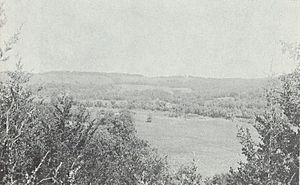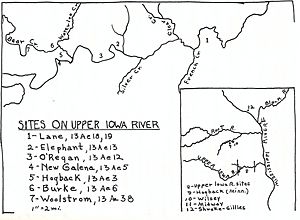Upper Iowa River Oneota site complex facts for kids
Quick facts for kids Upper Iowa River Oneota site complex |
|
|---|---|

View of O'Regan Site
|
|
| Location | on the Iowa River in Allamakee County, Iowa |
| Lua error in Module:Location_map at line 420: attempt to index field 'wikibase' (a nil value). | |
The Upper Iowa River Oneota site complex is a group of seven important archaeological sites in Allamakee County, Iowa. These sites are all very close to each other, located on or near the Upper Iowa River. They belong to a group of ancient people called the Oneota, who were part of the Late Prehistoric Upper Mississippian culture.
These sites are special because some of them contain early European trade goods. This tells us that people lived here even when Europeans first started arriving in North America.
All seven sites were dug up and studied in 1934 and 1936. This work was done by Dr. Charles Reuben Keyes and Mr. Elliason Orr.
Here are the names of the seven sites:
- Lane Village site and mound group (13Ae18 and 13Ae19)
- Elephant Cemetery site (13Ae13)
- O'Regan Cemetery site (13Ae12)
- New Galena mound group (13Ae5)
- Hogback site / Flatiron terrace (13Ae3)
- Burke site (13Ae6)
- Woolstrom site / Flynn Cemetery (13Ae38)
A full report about these sites was written in 1959 by Mildred Mott Wedel. Because the sites were so similar and close, the information from all of them was studied together.
Contents
What the Area Was Like
The Upper Iowa River valley had many different ecosystems. These natural areas provided lots of resources for the people who lived there long ago.
River Life
The river itself was a great source of food. It had many fish, mussels, and turtles for the ancient people to catch.
Farming and Forests
The flat land next to the river, called the floodplain, had rich soil. This soil was perfect for agriculture, meaning the people could grow crops. The higher lands overlooking the river were covered in thick forests. These forests had trees like oak, maple, hemlock, and elm. There were also nut trees such as hickory, black walnut, and butternut. These nuts added to the food grown through farming.
Wild Animals
The forests were also home to deer, which the people could hunt. Beyond the forested areas were wide open prairies. These prairies were where animals like elk and bison lived.
The Orr Focus People
The Orr focus is a specific group of the Oneota cultures. These cultures lived across the American Midwest in ancient times. They were present from the late Prehistoric period up to when Europeans first arrived.
How They Lived
Like most Oneota groups, the Orr focus people mostly got their food by farming. They also hunted animals, fished in the rivers, and gathered wild plants. This mix of activities helped them survive and thrive.
Important Sites
The seven sites in the Upper Iowa complex are very important. They are considered the main examples for studying the Orr focus. Other Orr focus sites are found in Wisconsin, like Shrake-Gillies, Midway, and Pammel Creek.
Unique Pottery
The Orr focus is different from other Oneota groups mainly because of its unique pottery. Their pottery often has straight-line (rectilinear) designs instead of curvy ones. It also frequently has small notches along the rim or lip of the pot.
Connecting with Other Groups
Archaeologists have noticed that pottery from the Huber Phase, found near Chicago, looks very similar to Orr focus pottery. For example, a type of pottery called Huber Trailed is thought to be much like Allamakee Trailed pottery from the Orr focus. Both have straight-line patterns, notched lips, and similar shapes.
Dating the Cultures
Both the Orr focus and Huber cultures existed from the late Prehistoric period into the early Historic period. Scientists use radiocarbon dating to find out how old things are. Samples from the Lane site (an Orr focus site) show dates between A.D. 1426 and 1660. Huber sites also have similar dates, and some even have European trade goods, showing they were around when Europeans arrived.
The Ioway and Otoe Tribes
The seven sites on the Upper Iowa River are in the same area where early French explorers and fur traders met the Ioway Native American tribe. Most archaeologists agree that the Orr Phase pottery represents the ancient culture of the Ioway tribe. It also represents the culture of the closely related Otoe tribe.
Why These Sites Are Important
The work done by Keyes and Orr in digging up these seven sites was very important. It led to the discovery of a new part of the Upper Mississippian culture group, called the Oneota Orr focus.
The most important artifact that helps identify this group is their pottery. It's called Allamakee Trailed pottery and is made with crushed shell. The artifacts found at these sites confirm that the Orr focus existed in the late Prehistoric and early Historic periods. It is believed that these sites show us the ancient culture of the Ioway and Otoe tribes.


